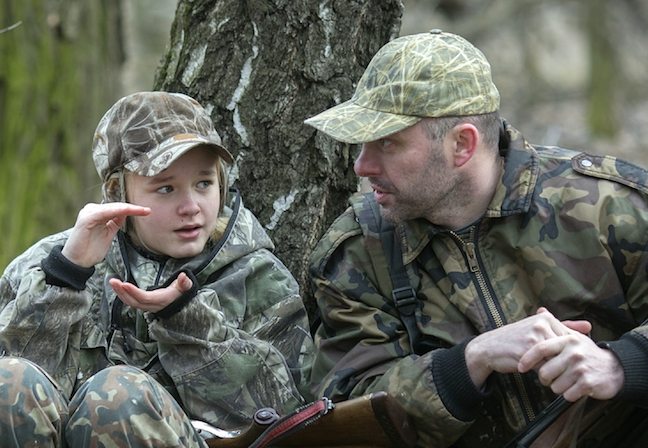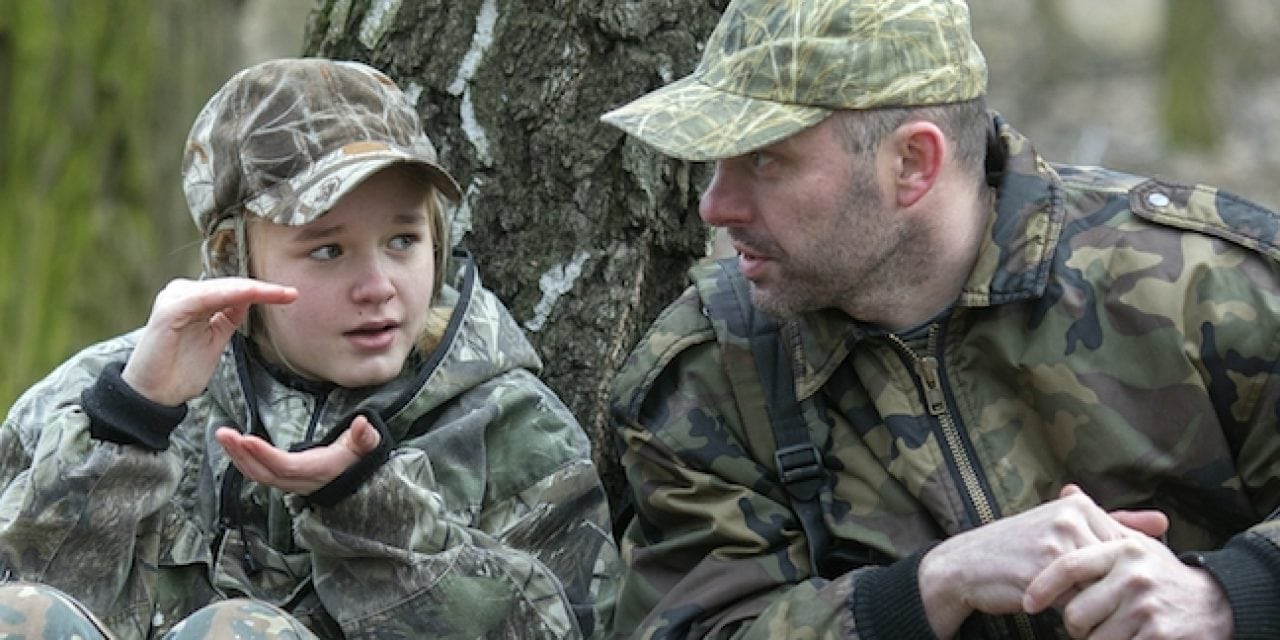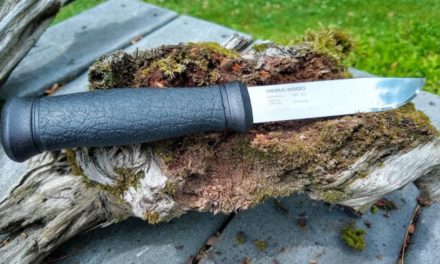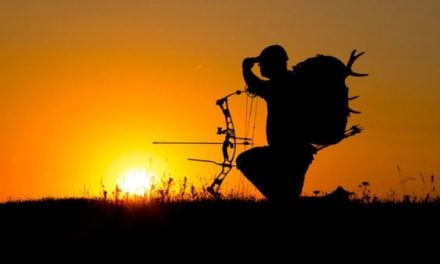Nationwide rabbit hunting (including hares) is the fourth most popular hunting endeavor for sportsmen.
Hunters hit the woods and fields for a variety of reasons. For some it is mainly about sport and challenge while others hunt for meat or camaraderie.
Rabbit hunting is almost unmatched when it comes to providing all the above.
Sport, challenge and meat are obvious. However, the camaraderie with rabbit hunting is a step above many other types of hunting.

Hunting in groups of two or more makes rabbit hunting fun and informative. (Shutterstock image)
Stealth and quiet are components of most hunting. Often, the hunter is alone and must remain very quiet in order to get within range of the quarry.
That is not the case with rabbit hunting. Hunting is often done in pairs or groups, and there is lots of movement, commotion and usually a few dogs.
Talking, laughing and generally having a good time is the norm. It is one of the most fun hunts a person can enjoy.
Indiana was once a mecca of rabbit habitat, but things have changed a lot over the past 20 to 30 years. In years past, the Hoosier landscape was dotted with family farms and lots of scrub land.
Rabbits like it messy and do best in areas with lots of weeds, brush, downed trees, honeysuckle, thorns and other debris.
Old junk farm implements, culvert piping, dozer piles and other locations with overgrown weeds are perfect for attracting rabbits.
Farmers used to leave treelines, ditches, field edges and other untillable land to grow up, and this made superb rabbit cover. Unfortunately, farming nowadays often means clearing every fence row, ditch and treeline possible.
SQUIRREL HUNTING POPULARITY
Rabbits are still very plentiful in Indiana in areas where there is a good amount of early successional habitat.
In much of the traditional farming areas, especially in the northwestern and east-central portions of the state, this habitat is mostly gone. Not only have changes in farming practices hurt rabbit populations, but urban sprawl and other land developments have subtracted from the overall landscape.
Still, we do have good numbers of rabbits in many areas of the state.
Rabbit hunting remains very popular with Hoosiers, and nationwide rabbit and hare hunting is the fourth most popular hunting endeavor for sportsmen.
The number of rabbit hunters here in Indiana fluctuates some, and the DNR is not able to pinpoint an exact number. But it is believed close to 150,000 people pursue rabbits annually in the state.
Success remains good, with hunters taking some 200,000 rabbits per year. Percentage wise, the success rate typically amounts to approximately three to four rabbits per hunter, with a hunter effort of about five or six days per year.
Private land offers the best chance of success for hunters who have exclusive access to properties and do not have to compete for the best spots. However, for those lacking these honey holes, there are lots of great options on our public lands.
Most all of the public hunting areas in the state have rabbit hunting opportunities available and some almost rival the quality of hunting on private land.
PUBLIC LAND STRATEGY
Hunting on public land can be great, but it also comes with some unique challenges. Many times hunting on private land means there are no other hunters utilizing the property.
That is certainly not the case with public land hunting. To find success, hunters must use a little more savvy and be willing to work a little harder than the other guy.
Being successful at the start of the season may simply mean getting to a spot earlier than anyone else. However, after a few days, there are hardly any easily accessible spots that haven’t been hunted. This is when hunters must be more dedicated to find consistent success.
Rabbit hunters are prone to just driving up and saying, “Hey, this looks like a good spot. Let’s give it a try.”
That may work on private land and may even work on public land early, but after all the “good looking” spots have been hunted a few times, a new strategy is required.
One of the best ways to stay in the game on public land is to think more like a deer hunter rather than a rabbit hunter.
Instead of just parking in a field and turning the dogs out, try doing a little research and find some spots that are farther away from the roads and parking areas.
Lead the dogs or leash them if necessary and get back away from the hardest hit areas and look for those out of the way spots other hunters may miss or be reluctant to hunt due to the distance.
A great way to find these spots is by studying a map of the hunting area. Maps of most FWAs and other public hunting lands are available on the Indiana DNR website. Mapping services such as Google Earth or MyTopo are also great options for finding hunting locations.
Many properties have management practices that benefit cottontails, and hunting success runs high. Although numerous properties offer good rabbit hunting, we’ll take a look here at a few of the best bets in Indiana for this season.
PATOKA LAKE
This location is a very popular reservoir for anglers and other lake recreation enthusiasts, but it is also a great place for chasing rabbits.
The entire property totals about 26,000 acres, and the lake totals just less than 9,000 acres. So, that leaves some 17,000 acres of land with good diversity and mixed habitats.
There are lots of great places to hunt and the property usually yields an annual hunting harvest in excess of 200 rabbits.
There are several different sections to the Patoka Lake property, so getting to know the property helps with hunter success. Driving around the property and also studying maps of the area helps hunters target some of the best areas to try.
Keep in mind though that this property has many site-specific regulations and some areas off limits to hunting just as do many of the fish and wildlife areas (FWA). Hunters must check in and out daily and carry a hunt card while in the field.
GLENDALE FWA
One of the most consistent public lands is the Glendale FWA near Montgomery. This location has over 8,000 acres of land, and there are plenty of spots that hold good numbers of rabbits.
There are several lakes, ponds, wetland areas and also some border property along the East Fork White River. Along with the ample fertile habitats near the water sources, there are mixed hardwood forests and plenty of upland habitats.
Hunters are typically very successful at Glendale, and the average hunter harvest is between 300 and 400 rabbits annually. Some years the total pushes well above 400 rabbits.
The downside is this property does get a lot of hunting pressure, so consequently the best rabbit hunting success usually comes at the first of the season. After that, rabbit numbers are down some. Also, the hunting pressure pushes remaining rabbits into tighter habitats, and they generally are more prone to sitting tight and not jumping as quickly.
Success in the later weeks of the season usually requires getting farther away from the roads and parking areas to locations not pounded daily by hunters.
It also generally requires some good jump dogs that are not shy about burrowing into the thick stuff to flush out bunnies holding tight within the cover. Daily check-in is required for all hunters. Area F is designated for dog training.
J.E. ROUSH LAKE FWA
This is another very consistent public land for producing good rabbit hunting. Annual harvest numbers for cottontails at Roush is very similar to those at Glendale FWA.
The FWA lies adjacent to the Wabash River, so there is a lot of fertile bottomland on the property. A good mixture of woods, fields and brushy areas is available.
During some years, the J.E. Roush Lake FWA leads the state in rabbit harvest figures.
As with Glendale, hunter pressure for rabbits is quite high, especially the first weeks of the season.
Hunters must check in daily and obey hunting season and bag limits. Dog training is allowed in Area 22.
KINGSBURY FWA
Hunters within driving distance of La Porte may want to consider the Kingsbury FWA. It borders the Kankakee River and has lots of great rabbit habitat. There are river bottom areas as well as a good mix of woods, fields, grass, brush and farm fields with row crops.
Rabbit hunters usually do very well at Kingsbury, and the property often ranks annually in the top five for public land cottontail harvest.
Kingsbury totals over 7,000 acres, so there is plenty of room to accommodate a good number of hunters.
A down year may put the harvest under 200 rabbits, but more typical is 300 or above. During a really good season the harvest can approach or even exceed 500 rabbits.
There are three refuges on the property where hunting is not permitted. These areas are marked with signage, but to be safe, hunters should obtain and study an area map before hunting. Maps are available on the DNR website and at a self-service kiosk at the property. Check-in is required, and hunters must carry a hunt card while in the field.
BEST OF THE REST
These are some of our top choices for this season, but they are certainly not the only public lands offering good opportunity. In fact, most all of the public lands in Indiana that offer rabbit hunting provide a decent amount of opportunity.
Of course, some properties obviously have more habitat that is better suited for rabbits, and subsequently for rabbit hunters. Here are a few others that just missed our top locations list, but still offer great chances to bag a few bunnies.
Pigeon River FWA near Mongo has close to 12,000 acres and usually provides good hunting. The property has seen some big swings up and down in hunter success in recent years, but when rabbit numbers are up and weather cooperates, this property is a great choice for bagging some cottontails.
Winamac FWA is another spot that is a great choice most years. It has some ups and downs, but generally produces good success for rabbit hunters. It has recently been in the top five in the state for rabbit harvest.
We discussed Roush Lake FWA and Patoka Lake, but they are not the only reservoir properties offering good rabbit hunting. Mississinewa Reservoir and Salamonie Reservoir are excellent options for chasing cottontails.
The Mississinewa property includes Red Bridge State Recreation Area, Pearson Mill SRA, Frances Slocum SRA and Miami SRA. The Salamonie property includes Dora-New Holland SRA, Mount Etna SRA, Mount Hope SRA, Lost Bridge East SRA and Lost Bridge West SRA.
Now that we’ve highlighted some of the state’s most productive areas and a little strategy for increasing hunting success, it’s time for you to hit the woods at one of the locations noted above or another hotspot near you.
The post Rabbit Hunting Strategies for Autumn appeared first on Game & Fish.
















